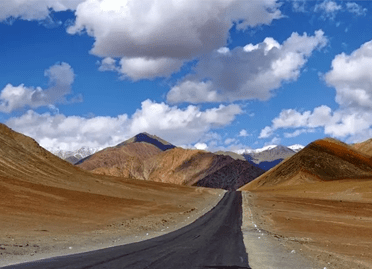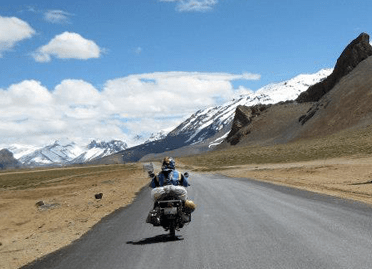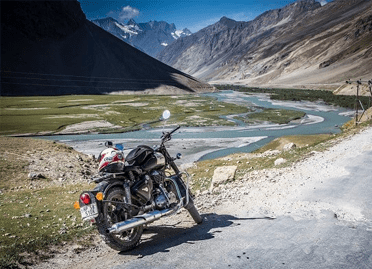Where am I : India Tour Packages » Most Popular Packages » Khardungla Tour Packages
View Details

Destinations Covered : Leh » Khardungla » Leh
View Details

Destinations Covered : Leh » Pangong Lake » Khardungla » Leh
View Details

Destinations Covered : Leh » Pangong Lake » Alchi Likir » Khardungla
Khardungla Pass Tour Pacakge
- Price of Khardungla Pass Packages
- (Per person on twin sharing)
- Standard Nights Best Of Ladakh
- Price on Request - 5 Days and 5 Nights
- Price on Request - Indus Creed - Standard
- Four Nights
- Indus Creed - Deluxe 4 Nights Price on Request -
- Deluxe Best Of Ladakh Price on Request - 5 Nights
History of Khardungla Pass
This mountain route in Ladakh's newly formed union territory was built for motor vehicles in 1976 and opened to the public in 1988. The first attempt to offer China a good war was made through this path during the Second World War. Khardung La, like every other high altitude pass, is maintained by BRO (Border Roads Organisation). This road is essential to India not only from a tourism standpoint but also from a strategic standpoint. It's a route for transporting goods and troops to the Siachen Glacier, making it a crucial pass for India.
Khardong La is historically significant since it is located on the main caravan route connecting Leh and Kashgar, Central Asia. Around 10,000 horses and camels used to travel the route each year, and a small herd of Bactrian camels can still be observed north of the pass at Hunder. "The trail, after crossing the Indus, separates, one branch heading south along the river's edge to Spitok, Khalatse, and Kargil, the other turning north to Leh, the Khardong Pass. and Yarkand, an ancient trading city of Sinkiang," wrote William O. Douglas in the early 1950s. [3] "Leh is on a historic caravan route that connects not only to Yarkand, Sinkiang but also to Lhasa, Tibet, he explains.
The flow of commerce From the north came wool, silver, felts, tea, sugar, skins, velvets, silk, gold, carpets, musk, coral, borax, jade cups, and salt. Cotton shawls, brocades, opium, indigo, plumes, pearls, ginger, cloves, pepper, honey, tobacco, sugar cane, barley rice, wheat, and corn all came up from the south. During World War II, an attempt was made to transport war materials to China using this route.
Hundreds of GPS surveys yielded a 5,359 m (17,582 ft) elevation that matches SRTM data, ASTER GDEM data, and Russian topographic mapping. It's in line with a lot of other GPS reports.
Leh is the closest large town. Leh is accessible by road from Manali and Srinagar, and regular flights from Delhi are available. A daily bus route from Leh to Nubra Valley travels through Khardung La, which can also be reached by leased car or motorcycle with a skilled driver. North Pullu and South Pullu are the two bases on either side of Khardung La.
Is the Khardungla Pass the highest point in the world?
The road is one of the highest motorable roads in the world. Khardung La is 5,359 meters above sea level (17,582 ft). Local summit signs and dozens of t-shirt shops in Leh falsely claim that its elevation is around 5,602 m (18,379 ft) and that it is the world's highest motorable pass.
How tall is the Khardung La pass?
5,359 meters
What exactly is the mighty Khardung La?
Khardung La, at an elevation of 18,379 feet, is the world's highest motorable road and serves as a gateway to the Shyok and Nubra valleys in India's northernmost state, Jammu and Kashmir. It is a high mountain pass located to the north of Leh in the Karakoram Range.
Why will you fall in love with Khardungla Pass?
The famous gateway to the Nubra and Shyok Valleys in Jammu and Kashmir's Ladakh region. It is the world's highest motorable pass. It is teeming with tourists who have crossed from Leh and stopped to take photographs. It is a place where nature can be found in its purest form.
Natural wonders charmingly adorn Ladakh, from lush green pastures to scenic lakes like Pangong Tso. This cold dessert is extremely awe-inspiring due to its unbelievable, magical, and superb landscape.
What distinguishes Leh Ladakh from other places?
Ladakh, often known as Little Tibet, is a famous tourist destination since it is home to one of the few original instances of Tibetan Buddhist culture still in existence. Visitors come to observe a preindustrial culture, visit Buddhist temples, and take in the breathtaking environment. With its snowcapped peaks, pure blue skies, and desolate mountains with meandering rivers, Ladakh is breathtaking. Ladakh, commonly known as "the Land of High Passes," is a breathtakingly beautiful Indian region. It is well-known for its visual beauty as well as some of the most demanding treks. Here are some breathtaking photographs of Ladakh that highlight the beauty of the region.
Historical Monuments in Khardungla Pass
Monastery of Alchi
Alchi monastery, in the Leh district's Alchi village, is home to some of Ladakh's oldest and most archaic historical sites. The intricate wood carvings and paintings depicting Kashmiri and Buddhist history are captivating. You will fall in love with the Alchi complex's unique sculptures and traditional architectural approach as you begin to discover its beauties.
The principal highlights of this complex of antique sculptures include a large Buddha statue, The dukhang, The Sumtseg, and Manjushri la-Khang, in addition to century-old paintings.
Alchi village is located in the Leh district of Ladakh.
The ideal time to visit: The months of June to September are regarded to be the best for seeing this magnificent historical site in Leh.
Diskit Gompa
Diskit Gompa is a Buddhist monastery in Diskit, Nepal. It was founded in the 14th century by Changzem Tserab Zangpo and is one of Ladakh's largest historical sites. The old Maitreya Buddha statue attracts history buffs, and the sacred site also gives a magnificent panoramic view of Nubra Valley.
Monastery of Thiksey
Thiksey, located at an elevation of 11,800 feet above sea level, is one of Ladakh's most notable historical sites. The design and buildings of the monastery excellently depict the serenity of Tibetan culture. You can appreciate the breathtaking views of the entire Ladakh valley as well as the tranquillity of this spot.
Takthok Gompa
For centuries, Takthok Gompa has been protecting the holy book of Buddha's teachings in 108 volumes, called Kashur. Besides presenting the accuracy and divinity through their ancient paintings and statues, this place shelters 55 Lamas in Ladakh. Best time to visit: it's best to visit the place during summertime (May to September) for the famous monastery festival.
Sani's Castle
This monastery, which was erected in the shape of a fortress, is one of the most important historical sites in Ladakh because of its rich pre-Tibetan architecture. Muras depicting Padmasambhava's life can be found throughout the temple. This monastery was founded by Kushan emperor Kanishka and is one of the world's eighty revered Buddhist sites.
If you travel during the 6th month of the Tibetan calendar, you will be able to see the sacred monument of Naropa, which is one of Ladakh's most important historical landmarks.
Sani village is located in Ladakh.
Best time to visit: The months of June through November are ideal for visiting this sacred site.
What are the top 10 fascinations to visit in Khardungla Pass?
Khardung La is a mountain range in Tibet.
Khardung La, at an elevation of 18,379 feet, is the world's highest motorable road and serves as a gateway to Ladakh's Shyok and Nubra valleys.
Lake Tsomoriri
The beautiful beauty of Tsomoriri Lake is well-known. Between Ladakh in the north, Tibet in the east, and Zanskar in the west, the high-altitude lake is located. At an elevation of 15,075 feet, it is India's highest brackish water lake.
Monastery of Lingshed
In the Zanskar region, Lingshed Monastery is a Gelugpa Buddhist monastery. It is home to approximately 60 monks. It has six main shrines, kitchens, storerooms, and a residence for Ngari Rinpoche or other visiting high lamas on the top floor.
Zanskar
Zanskar is a high-altitude semi-desert in the Great Himalayan Range's northernmost region. Zanskar is an ideal vacation destination due to its pleasant climate, barren landscapes, snow-capped Himalayan Mountains, and sparkling rivers.
Chun Sumda
Sumda Chun, located at an elevation of 12,000 feet, is famous for the temple built by Lotsawa Rinchen Zangpo. This village is only accessible via a 5-hour steep river valley trek.
Monastery of Thiksey
Thiksey Monastery in central Ladakh's largest gompa. The monastery is 3,600 meters above sea level.
The Markha Valley
The Markha Valley climb is one of Ladakh's most popular and beautiful hikes. Popular attractions include panoramic views, Tibetan Buddhist monasteries, and distant communities.
La Chang
Chang La is 17,586 feet above sea level. It is the world's third-highest motorable road. The name means "Southern Pass" or "Southern Pass."
Nubra Valley is a small town in the Nubra Valley
The Nubra Valley is a tri-armed valley to the northeast of Ladakh. Nubra is a chilly desert at a high altitude with sparse flora.
Monastery of Hemis
Hemis Monastery is a Drukpa lineage Tibetan Buddhist monastery. In early June, the annual Hemis festival commemorating Padmasambhava takes place.
Tip for those who are going on a Khardungla Pass tour
Khardung La weather
From May to August, the months are ideal for exploring Khardung La, which is home to the highest peak in the Himalayas. Temperatures in this area vary greatly depending on the clouds, making temperature estimation impossible. Due to the high altitude, snow can fall at any time, even during the summer months.
However, the temperature can drop to -40 degrees in the winter and rise to 20 degrees in the summer. And when it snows, the area can become engulfed in 10-foot-high snow sheets, but thanks to BRO, the snow is kept clear for easy commuting. Road Conditions to Reach Khardung La
How to Get There
Khardung La is 39.7 kilometers from Leh and does not have an airport, so you must fly to Leh and then take a taxi to Khardung La Pass. If you are suffering from AMS in Leh, avoid traveling there and instead wait for the symptoms to go away.
- To go to Khardung La from Leh, it's best to hire a taxi or ride a bike. Travelers will arrive at their location in 1 hour and 23 minutes by automobile. You can get to the pass in 1 hour and 15 minutes if you ride a bike.
- A daily bus service runs from Leh to Nubra Valley, passing through Khardung La Pass.
- If you're not driving on your own on this pass, hire an experienced driver.
- Take the appropriate altitude sickness medication.
- There is no accommodation in Khardung La Pass. You have the option of bringing your tent or staying in one of the surrounding towns.
- To enter this pass, you must have a valid travel permit. Tourism departments and travel agencies can provide it. A travel firm can be engaged to help obtain the permission quickly, but this comes at a fee.
- If you're traveling by bike, have it serviced by any Leh mechanic. Because the journey will be difficult. To manage the tough road conditions, the bike must be in good working order.
- The distance between Leh and Khardung La is about 40 kilometers, with a patchy road and a large amount of it muddy, packed with snow melted slush, granules, and other obstacles. Reaching Khardung La is a once-in-a-lifetime experience. Being at such a high altitude, however, is hardly a child's game.
- The first 24 kilometers of the road from Leh to Khardung Pass, or until the South Pullu checkpoint, are made of concrete. The next 16 kilometers of road, up to North Pullu, are uneven, with dirt, loose rocks, and puddles of snow-melted water.
What should you carry to Khardung La?
Take precautions against acute mountain sickness and acclimate well before trying the pass. Drink plenty of water and have chewing gum, chocolate, and energy foods on hand to stay hydrated.
Keep some oxygen substitutes on your hands, such as camphor or portable oxygen cylinders, and a first-aid kit in your backpack. Woollen clothing, additional socks, and raincoats are essential, as well as a high-quality camera for capturing unforgettable moments. It is best to wear sturdy shoes, hiking boots, or riding boots, and ensure that all of your electronics are fully charged before heading out on the trail.
Is it possible for us to visit the Khardungla Pass?
To cross via Khardung La, tourists must have an Inner Line Permit (ILP). The ILP is available through the Leh District Commissioner's office. It's a good idea to have roughly 6 copies of the ILP with you because they'll be needed at checkpoints along the way.
Is the highest motorable road in Khardung La?
At 18,600 feet, the road, which was opened today, will be the world's highest motorable road for the general public." At 18,380 feet, the Khardungla Pass was the world's highest motorable road for the general public until today.
Is the Khardungla Pass secure?
It's a pretty safe area to go. However, because the elevation of this location is 5602 feet, you may have Acute Mountain Sickness.
How do I obtain a Khardung La pass?
To cross via Khardung La, tourists must have an Inner Line Permit (ILP). The ILP is available through the Leh District Commissioner's office. It's a good idea to have roughly 6 copies of the ILP with you because they'll be needed at checkpoints along the way.
Where to stay in Khardungla Pass
- Morning Sky Guest House...
- New Royal Guest House... Here is a list of the 22 Best Places To Stay In Leh.
- Yarab Tso, a.k.a. Yarab Tso, a.k.
- The Indus River Camp is located on the banks of the Indus River. 7.5 kilometers from the city center
- Hotel Ladakh Greens is located 1.0 kilometers from the city center.
- Obar. 1.4 kilometers from the city center
- New Moon Guest House is a great place to stay if you're looking for 1.9 kilometers from the city center
- Raku Guest Home is a guest house located in Raku, Japan. The city center is 1.5 kilometers away.
- The Khardung La pass is accessible from 9:00 a.m. to 5:00 p.m. and evening.
How to get it?
By Air
To access Nubra Valley, as well as any other part of Ladakh, travel permission is required. Khardung La Pass is accessible by three modes of transportation: air, train, and road. By Air: Leh International Airport in Leh is the closest airport to Khardung La Pass.
By ROAD
The route from Leh to Khardung La has an asphalted road for about 24 kilometers till the South Pullu checkpoint, after which it becomes gravel and dirt track until the North Pullu checkpoint.
By Train
Jammu Tawi Railway Station is the closest railway station. It has excellent connections across India. You may simply catch buses and cabs to Khardung La Pass after exiting the railway station.
Rental cars services in Khardungla Pass
Car Rental in Leh, Ladakh
Innova Car, Tempo Traveller, Scorpio Car for Ladakh Sightseeing, Manali to Leh Drop, Nubra Pangong Leh via Car Hire, and Nubra Pangong Car Rentals are all available at Leh Ladakh Car Rentals.
Can I drive my car to Leh?
Using either of the two routes, you may securely transport a self-drive cab to Leh. When you wish to go to surrounding locations like Pangong and Nubra, though, things get a little more complicated. To do so, you'll need to park your car in Leh and hire a local cab from there to tour you around.
Why are self-drive rental cars not permitted in Leh Ladakh?
It all started in June 2015, when the Ladakh Taxi Union passed their own (unapproved by the administration, please read) resolution that the tourism potential of Ladakh is being exploited through the use of malpractices such as privately hired vehicles (white number plate vehicles), self-drive vehicles (black number plate vehicles), and commercial motorbikes in Ladakh.
Khardungla Pass Important instructions when you rent your car
Is it possible to hire a car in Ladakh?
Unfortunately, renting a self-drive automobile in Leh Ladakh is not an option. To view the wonders of Ladakh, you'll need to book a local cab in Leh. If it's possible for him, you can ask the local driver to allow you to drive for a few stretches.
Is it legal to drive a private automobile in Leh?
So, if you're heading to Ladakh in a hired cab, you'll need to book another one in Leh to get to Nubra and Pangong. There are no restrictions as long as your privately owned car is not more than ten years old.
Can I travel to Ladakh via Zoomcar?
Yes, you may travel to Ladakh in your own or private automobile. Cars with white number plates registered in your name, your wife's name, or your father's name are permitted to drive throughout Ladakh and visit destinations such as Nubra Valley, Pangong Tso, and Tso Moriri.
Is there an automobile that can get you to Ladakh?
You may travel in automobiles like the Toyota Fortuner, Mitsubishi Pajero, or Mahendra Scorpio, which are capable of navigating tough terrain. Fuel Capacity: On your drive to Ladakh, you may not come across many gas stations.
Speak to our Experts!
Instant Quote, Best Deals - 100% Customizable, Includes hotels + car + guides Cost depends on various factors like, number of people you are, travel dates, category of hotel and transportation etc.Drop your Inquiry to get the best deals as per your requirements. 100% Satisfaction Guaranteed. Rated 5* in TripAdvisor.



